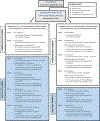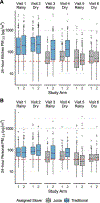Impact of the wood-burning Justa cookstove on fine particulate matter exposure: A stepped-wedge randomized trial in rural Honduras
- PMID: 33429278
- PMCID: PMC7919923
- DOI: 10.1016/j.scitotenv.2020.144369
Impact of the wood-burning Justa cookstove on fine particulate matter exposure: A stepped-wedge randomized trial in rural Honduras
Abstract
Trial design: We evaluated the impact of a biomass stove intervention on fine particulate matter (PM2.5) concentrations using an individual-level, stepped-wedge randomized trial.
Methods: We enrolled 230 women in rural Honduran households using traditional biomass stoves and randomly allocated them to one of two study arms. The Justa stove, the study intervention, was locally-sourced, wood-burning, and included an engineered combustion chamber and chimney. At each of 6 visits over 3 years, we measured 24-hour gravimetric personal and kitchen PM2.5 concentrations. Half of the households received the intervention after Visit 2 and half after Visit 4. We conducted intent-to-treat analyses to evaluate the intervention effect using linear mixed models with log-transformed kitchen or personal PM2.5 (separately) as the dependent variable, adjusting for time. We also compared PM2.5 concentrations to World Health Organization (WHO) guidelines.
Results: Arms 1 and 2 each had 115 participants with 664 and 632 completed visits, respectively. Median 24-hour average personal PM2.5 exposures were 81 μg/m3 (25th-75th percentile: 50-141 μg/m3) for the traditional stove condition (n=622) and 43 μg/m3 (25th-75th percentile: 27-73 μg/m3) for the Justa stove condition (n=585). Median 24-hour average kitchen concentrations were 178 μg/m3 (25th-75th percentile: 69-440 μg/m3; n=629) and 53 μg/m3 (25th-75th percentile: 29-103 μg/m3; n=578) for the traditional and Justa stove conditions, respectively. The Justa intervention resulted in a 32% reduction in geometric mean personal PM2.5 (95% confidence interval [CI]: 20-43%) and a 56% reduction (95% CI: 46-65%) in geometric mean kitchen PM2.5. During rainy and dry seasons, 53% and 41% of participants with the Justa intervention had 24-hour average personal PM2.5 exposures below the WHO interim target-3 guideline (37.5 μg/m3), respectively.
Conclusion: The Justa stove intervention substantially lowered personal and kitchen PM2.5 and may be a provisional solution that is feasible for Latin American communities where cleaner fuels may not be available, affordable, or acceptable for some time. Clinicaltrials.gov: NCT02658383.
Keywords: Biomass cookstove; Exposure assessment; Household air pollution; Household energy; PM(2.5); Randomized controlled trial.
Copyright © 2021 Elsevier B.V. All rights reserved.
Conflict of interest statement
Declaration of competing interest Two of the authors, Sebastian Africano of Trees, Water & People (TWP), and Anibal Benjamin Osorto Pinel of Asociación Hondureña para el Desarrollo (AHDESA), are members of the implementing non-governmental organizations that deploy the cookstove technology presented in this manuscript. Publications like this are often used to support their cookstove technology in TWP and AHDESA blogs, articles, and grant proposals, which may lead to future funding of these initiatives by individual and/or institutional supporters of the respective organizations. As such, we disclose this information.
Figures


References
-
- Chengappa C, Edwards R, Bajpai R, Shields KN, & Smith KR (2007). Impact of improved cookstoves on indoor air quality in the Bundelkhand region in India. Energy for Sustainable Development, 11(2), 33–44. 10.1016/S0973-0826(08)60398-1 - DOI
-
- Cynthia AA, Edwards RD, Johnson M, Zuk M, Rojas L, Jiménez RD, Riojas-Rodriguez H, & Masera O (2008). Reduction in personal exposures to particulate matter and carbon monoxide as a result of the installation of a Patsari improved cook stove in Michoacan Mexico. Indoor Air, 18(2), 93–105. 10.1111/j.1600-0668.2007.00509.x - DOI - PubMed
-
- Health Effects Institute, Global Burden of Disease Study 2019, & IHME (2020). (2020). State of Global Air 2020. https://www.stateofglobalair.org/data/#/air/plot
Publication types
MeSH terms
Substances
Associated data
Grants and funding
LinkOut - more resources
Full Text Sources
Other Literature Sources
Medical

